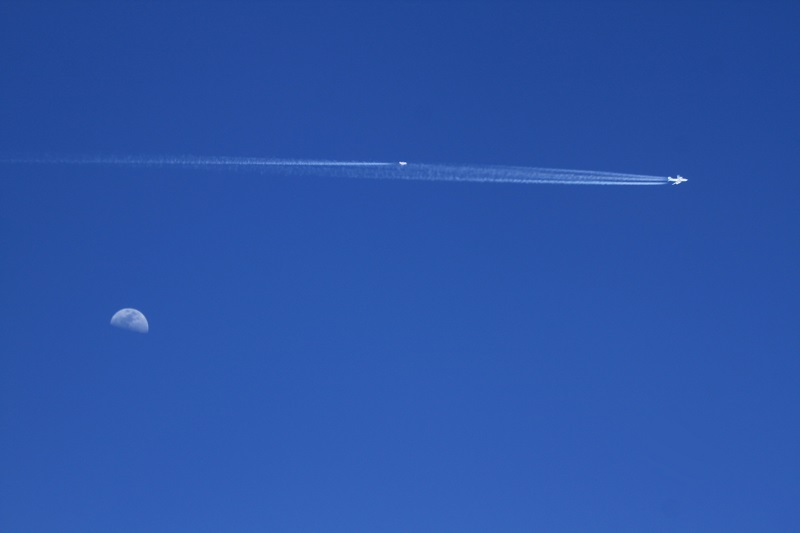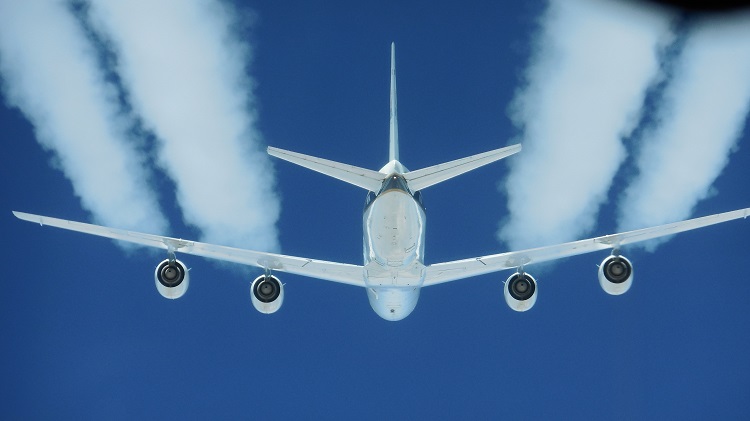Jet Flies Hot on the Heels of Biofuel-Burning Aircraft (Photo)

A small jet can be seen hot on the trails of a larger aircraft flying at an altitude of 34,000 feet (10,363 meters), as the two planes streak across a backdrop of the moon visible in the daytime sky.
In this photo, a fast-flying Falcon 20-E5 jet can be seen coming within 300 feet (91 m) of NASA's massive DC-8 plane. The aerial pursuit was part of the agency's ACCESS II mission, which is designed to measure how different aircraft fuels influence air quality — and, ultimately, climate change — by flying a jet close behind a plane and studying its emissions.
Richard Moore, a postdoctoral fellow at NASA's Langley Research Center in Virginia, snapped a photo of the high-flying chase on May 7, during one of the mission's test flights over Edwards Air Force Base in California. NASA's Earth Observatory released the photo today (Oct. 14). [Holey Clouds: Gallery of Formations Cut by Airplanes]
Last year, during a similar mission, safety regulations prevented the chaser jets from flying too close to the larger aircraft, or flying directly in its emissions wake. Flying through the wake is dangerous and can make for a bumpy ride, even when keeping 15 miles (24 km) back, which is the closest the pilots were willing to trail behind the DC-8.
"It was something like a roller coaster at times, as we were twisted one way or another," Bruce Anderson, ACCESS principal investigator from NASA's Langley Research Center, said in a statement. "And yes, it was a good idea to keep the airsickness bags handy."
During the mission, the huge DC-8 aircraft burned either JP-8 jet fuel or a half-and-half mix of JP-8 fuel and renewable biofuel made from Camelina plant oil. The DC-8 has four engines that can alternate between the two different fuel types. Three jets took turns chasing the larger aircraft from distances ranging from 300 feet to 20 miles (91 m to 32 km) behind, each time collecting data on the larger plane's emissions.
"Our findings show we definitely see a 50 percent reduction in soot emissions from the DC-8 when it burns the blended fuel as opposed to jet fuel alone," Anderson said.
Get the world’s most fascinating discoveries delivered straight to your inbox.
Although the blended biofuel emissions are definitely cleaner, scientists are still determining if the biofuel produces less contrails (condensation trails) than regular jet fuel does. Contrails are the streaks of man-made clouds that aircraft leave behind during flights. While they may look pretty on a clear day, the general consensus among scientists is that contrails warm the planet and could be contributing to climate change. The artificial clouds form when the exhaust fumes from aircraft mix with cold air. They trap more outgoing radiation from Earth than they reflect incoming radiation from the sun, but it's unclear how much more, according to NASA scientists.
Researchers can measure the contrails that both fuel types produce by comparing how many ice particles form and how many soot particles are released from each kilogram of fuel burned. Scientists are still working on analyzing the data collected during the latest ACCESS II test flight.
Follow Kelly Dickerson on Twitter. Follow us @livescience, Facebook & Google+. Original article on Live Science.




